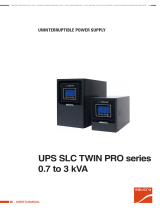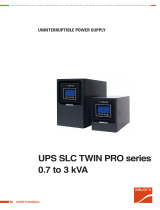Page is loading ...

1800 Series Single Phase Uninterruptible Power Systems
Product Specifications – Rev 3.0 August 2008
2.4 kVA
Page 1 of 6
1.0 Scope
This specification describes the Toshiba On-Line Uninterruptible Power System (UPS),
1800 Series. The series will supply a computer grade AC output sine wave which is
unaffected by the quality of the AC input. The input voltage is single phase and the
output voltage is single phase.
2.0 General Operation
Under normal operating conditions, the UPS' rectifier converts alternating current (AC
power) to direct current (DC power), which is required for the system's inverter and
battery charger. The charger supplies regulated DC power to keep the batteries
constantly charged. The inverter uses pulse width modulation (PWM) that fully utilizes
the characteristics of insulated-gate bipolar transistors (IGBT) to convert DC power to
regulated AC power. Therefore there is a constant supply of power. The batteries will
instantaneously supply the inverter DC power should an AC power line failure occur.
2.1 Performance Standards
The UPS is designed with the applicable sections of UL, CUL, and ISO 9001 14001. The
UPS has UL, CUL and CE listing.
3.0 General
3.1 Materials
All materials used are of new manufacture using the latest technology and has not been in
prior service except for specified factory testing. IGBT's (insulated-gate bipolar
transistors) are used exclusively in inverter sections.
3.2 Components
All functioning components are solid state with no moving parts.
3.3 Installation
The installation of the UPS complies with the UPS manufacturer's recommendations that
are supplied with the delivery of the UPS. The UPS is complies with Local electrical
codes and the National Electric Code. All wiring complies exactly with what is specified.
3.4 Assembly
The UPS is delivered fully assembled and be fully functional.
4.0 System Theory and Operation
4.1 Theory
AC input from the utility system is converted into DC power. The stepped up DC power
is then converted to AC power by the inverter. The output voltage waveform of the
inverter will be the pulse voltage waveform modulated by the PWM control using the
37.5 kHz switching frequency sine wave. The PWM-Modulated voltage waveform is
transformed into a sine voltage waveform by the inductive component of the inverter
inductor and by the capacitive component of the capacitor filter. The inverter uses the

1800 Series Single Phase Uninterruptible Power Systems
Product Specifications – Rev 3.0 August 2008
2.4 kVA
Page 2 of 6
IGBT with a self-extinguishing function and a high switching speed. Optional input and
output transformers for extra power conditioning.
4.2 Modes of Operation
4.2.1 Emergency (Battery Backup)
In the event the AC power from the utility system fails, the DC power is supplied from
the batteries to the chopper and to the inverter to provide a continued and stable AC
power supply to the load without interruption.
4.2.2 Normal (Inverter)
The rectifier converts AC to DC to power the inverter, which supplies power to the
critical load and simultaneously float charges the batteries.
4.2.3 Battery Charge
The charger will float charge the batteries in normal and bypass modes.
4.2.4 Static Bypass
If the UPS unit is in severely overloaded or develops an internal fault, power is
automatically switched from the units’ main circuit to the bypass circuit. Power is
conditioned by line filters, and the isolation transformer during static bypass operation.
5.0 UPS Input
5.1 System Rating The UPS is sized to supply a load with a power factor of 0.70.
5.2 Electrical Requirements
Voltage: 208/240 VAC Single Phase
Voltage Range : 240V: 144V~264V (+10% to -40%)
: 208V: 125V~228V (+10% to -40%)
Frequency: 50 or 60 Hz ±3Hz
Power Factor: Greater than 0.95
Input Total Harmonic Distortion: Less than 5% (current)

1800 Series Single Phase Uninterruptible Power Systems
Product Specifications – Rev 3.0 August 2008
2.4 kVA
Page 3 of 6
6.0 UPS Output
Voltage: 208/240 VAC Single Phase
Capacity: kVA kW (@ 0.70PF)
2.4 kVA (208/240V) 1596W
Regulation: +/-3% (with AC power and during battery backup)
Distortion: Less than 3% THD at full Linear Load
Step Load: ± 9 % max from 100% to 0 % or from 0% to 100 % linear load
Output Current: kVA
RMS PEAK
2.4 (240V) 9.5A 23.75A
Overload Capacity (Inverter): 150% for 30 seconds
125% for 60 seconds
Crest Factor: 2.5 at Full Load
Frequency: 50/60Hz Auto Sensing
Regulation: ± 0.5Hz
Synchronous Range: +/- 1 Hz
Wave Form: Sine wave, Zero Transfer Time
Load Power Factor: 0.7 lagging
Efficiency AC to AC: Greater than 79% (208/240V)
Noise Isolation: Neutral is bonded to ground on the output of the Isolation transformer
for isolation of common mode
Bypass: Manual bypass provided with switch with less than 4 ms transfer
7.0 UPS Battery
Battery Bus Volts: 48 VDC nominal
Backup time: 7 minutes
Type of Battery: Enersys NPX-35 Flame Retardant Lead Acid 9Ah/12V
Number of Battery: 2 Strings in Parallel, 4 batteries per String
Average Recharge: 9 hours (3.5 hours for 90%)
Cutoff Voltage: 1.6 Volts per cell

1800 Series Single Phase Uninterruptible Power Systems
Product Specifications – Rev 3.0 August 2008
2.4 kVA
Page 4 of 6
8.0 System Status and Control Indicators
8.1 Panel
The UPS has a panel on the front for complete monitoring control of UPS.
Operation panel features:
1) Run/Stop button
2) AC input voltage indicator
3) Inverter status indicator
4) Alarm indicator
5) Fault indicator
6) LED
Warning messages:
1) Low Battery
2) Current limit
3) Ambient Over Heat
4) Battery Over Heat
5) Input Over Voltage
6) Input Frequency Regulation
7) Output Overload
Fault Messages:
1) Replace Battery
2) Battery Shutdown
3) DC Bus Over Current
4) DC Bus Over Voltage
5) DC Bus Imbalance
6) Output Under Voltage
7) Output Over Voltage
8) System Over Heat
9.0 Dimensions
Tower
1.5 kVA 2.0 kVA 2.4 kVA
Weight 170 lbs 170 lbs 170 lbs
Width 10” 10” 10”
Depth 27” 27” 27”
Height 23.5” 23.5” 23.5”
10.0 Communications
10.1 Dry Contact Communication
The remote interface is a standard feature. Signals are available through a DB9 male
connector.

1800 Series Single Phase Uninterruptible Power Systems
Product Specifications – Rev 3.0 August 2008
2.4 kVA
Page 5 of 6
1) AC input present
2) Battery operation
3) Inverter
4) Bypass active
5) Fault
6) Loss of utility
10.2 RS-232C Communication
The RS-232C serial communication interface is available through a DB9 female
connector. The interface allows control of the UPS from a personal computer running
special Toshiba software.
10.3 EPO Control
The UPS comes with terminals on its rear side for receiving an Emergency Power Off
(EPO) and Remote Run/Stop command from a remote locations.
11.0 Reliability
Demonstrated mean time between failures (MTBF) of 200,000 hours.

1800 Series Single Phase Uninterruptible Power Systems
Product Specifications – Rev 3.0 August 2008
2.4 kVA
Page 6 of 6
12.0 Environment Operation
Operating Ambient Temperature: 0 ~ 40
o
C (32 ~ 104
o
F)
Recommended Temperature: +15
o
C ~ 25
o
C
Storage Temperature: -20
o
C ~ 40
o
C
Humidity: 30-90%, Non-Condensing
Audible Noise: 50dB (A) maximum @ 1 meter from Front Panel
Altitude: 1000 m (3,000 ft) above sea level
13.0 Conformance
UL 1778, CUL, CE, FCC Part 15 Class A
14.0 Warranty
Toshiba Standard warranty includes 3 Years of on site service which covers electronics
and labor, and a 5 year warranty on the batteries (2 years full, 3 years pro-rated)
15.0 Options
15.1 Remote Monitoring
The UPS contains a communication slot this allows the operator to field install an
optional RemotEye II card. The RemotEye II card allows the UPS to communicate via
Ethernet SNMP, connected directly to the Local Area Network. SNMP/ Web based
monitoring – Toshiba UPS system provides comprehensive monitoring of the UPS
operation. The optional RemotEye II features an HTTP (web-based) interface for
Toshiba UPS. This allows easy access to the Toshiba UPS information from any
PC/Network with a web browser.
15.2 Environmental Monitoring Device (EMD)
The EMD is an environmental monitoring device that provides remote monitoring of
temperature, humidity and other environmental conditions via standard web browser or
network management systems. The EMD provides automated events notification when
temperature, humidity or user defined dry contacts is out of configured tolerance.
/

